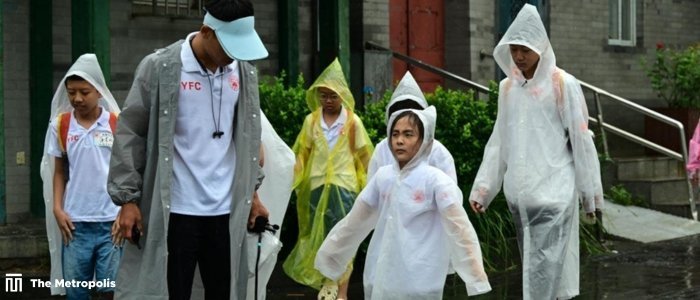The amount recorded in just 40 hours neared the average rainfall for the entire month of July.
Metropolis Desk-
As a mammoth cleanup effort got underway, Beijing’s weather bureau reported that the recent deadly rains in China’s capital were the hardest since records first started 140 years ago.
Extreme weather conditions and protracted heat waves have affected millions of people recently all across the world, according to scientists. These events are being made worse by climate change, they claim.
The capital’s recent downpour was the “heaviest in 140 years,” according to the Beijing Meteorological Service since the city began collecting statistics.
The biggest volume previously recorded was 609 millimeters in 1891, the service stated, adding that the largest (amount) of rainfall recorded during this storm, which was 744.8 millimeters, happened in the Wangjiayuan Reservoir in Changping.
Beijing’s state broadcaster CCTV reported on Tuesday that at least 11 people have died and more than a dozen are still missing as a result of the downpour.
On Wednesday, the flood’s center of activity moved to the nearby province of Hebei.
An AFP team observed a park that had flooded in Beijing’s Fangshan district, which lies on the border between the capital and Hebei, as well as masses of debris that had been washed away by the torrential rains stranded close to a bridge.
A police officer reported that the area had been “extremely dangerous” on Tuesday.
On its journey back from the worst-affected areas, a military vehicle with caterpillar wheels was also spotted by journalists.
Additionally, AFP observed an ambulance, a rescue boat, and a police vehicle traveling in the opposite direction toward Zhuozhou, a badly affected Hebei neighborhood. Inflatable rafts were being rowed by rescuers through flooded neighborhoods as residents clung to building scaffolding in anticipation of assistance, according to state media footage.
Former super typhoon Storm Doksuri, which last week tore across the Philippines, then moved northward over China after making landfall in southern Fujian province.
The normally dry nation’s capital and its environs were pummeled by heavy rains that started on Saturday.
The amount of rain that was recorded in just 40 hours was almost as much as the monthly average for July. 130 million people would be impacted by the extremely severe rainfall across northern China, state media said last week.
State media reports that 974,400 people have been evacuated from the capital and the nearby province of Hebei as swathes of suburban Beijing and the neighboring areas have been swamped.
And to the west, a further 42,211 people have been evacuated in Shanxi province.
Authorities in the capital lifted the red alert for flooding on Wednesday morning “as the water flow in major rivers has gone below the warning mark”, Xinhua reported.
As the rain stopped, attention turned to the relief effort. The Chinese Red Cross dispatched hundreds of workers to the worst-hit districts to clear away debris and assist in the evacuation of victims.
According to CCTV, two of the 11 persons killed in the rainstorm in Beijing perished while “on duty during rescue and relief”.
The station said that 14 more persons had been found safe while 13 remained missing. Nine people were murdered and six were reported missing in the neighboring province of Hebei, it said.
Over the weekend, the northern province of Liaoning confirmed two more fatalities.
On Tuesday, President Xi Jinping urged “every effort” to save individuals who were “lost or trapped” by the storm. In addition, Vice-Premier Zhang Guoqing called for “all-out” efforts to find those still missing while on a visit to a relief work site in Mentougou, one of the most severely affected regions of Beijing.
According to state news agency Xinhua, Zhang stated that the main objective of the ongoing work is to save as many lives as possible while also minimizing casualties.
Typhoon Khanun, the sixth typhoon of the year, is now bearing down on China’s east coast, and the nation is on high alert.
Source- NDTV



